Around 7.30 a.m. we dropped anchor in a broad estuary with the town of Corral to our right and Niebla hidden round a bend to our left. Wooded hills reached down to the water on both sides, reminding me of some of the Cornish estuaries. A large bulk carrier ship was moored to buoys on the shore to the right, suggesting mining activity I couldn’t identify, but the left shore appeared undeveloped.
The ninety-odd passengers on the ship had been allocated to one of four groups for going ashore by Zodiac inflatable boat. I was in Group 1 which would be the first group to go ashore to Niebla but on the next landing Group 2 would land first and the order of Groups would rotate throughout the trip. Landing was planned to start at 8.00 a.m. but there was a slight delay waiting for the coaches to arrive at the landing site.
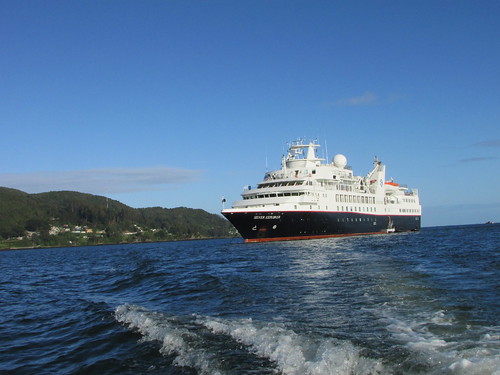
'Silver Explorer' anchored off Niebla, viewed from the 'Zodiac' taking me ashore.
Our anchorage was at the confluence of a number of rivers so the Zodiacs navigated by channel markers for the Valdivia River, the river on our left, and carried on for a few hundred yards to reach the public jetties at Niebla, provided with a concrete ramp for the vehicle ferries and two floating landing stages for small passenger ferries. We overtook one of the vehicle ferries ‘Cullamo’ which was heading for Niebla, I think from Corral. We landed at one of the passenger landing stages, stepping directly onto the landing stage (a ‘dry landing’). By the time I’d walked up the gangway from the landing stage, a passenger ferry had arrived at the adjacent landing stage and ‘Cullamo’ was preparing to unload vehicles. Niebla town may be small, but Niebla Terminal is a busy place.
Three modern tourist buses were waiting in the car park for the arrival of the ‘Silver Explorer’ passengers for the ‘Highlights of Valdivia Tour’. We had a local guide plus members of the ship’s Expedition Crew. The journey to Valdivia, we were told, would take about half an hour. The road continually curved this way and that, following the left bank of the Valdivia River upstream. The setting was very beautiful, again reminiscent of Cornwall.
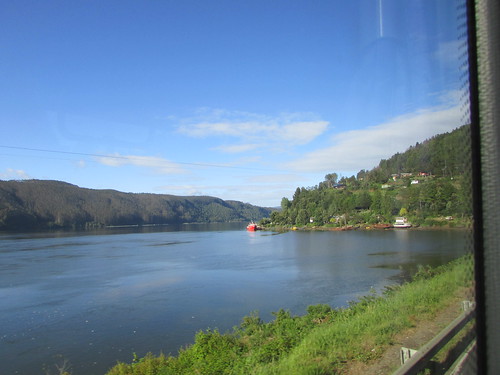
The river between Valdivia and Niebla, looking downstream.
At first, the houses were spread apart. They appeared to be mainly wooden framed, clad with chipboard and then with a clapboard or other outer layer. But as we came nearer to Valdivia, there were four-storey apartment blocks and gated communities of detached houses generally in an ‘Alpine’ style.
A little background
The Spanish conquistador Pedro de Valvidia founded the city in 1552, making it an important location in Spain’s South American colony. But the takeover was not accepted by the indigenous Mapuche Indian population and in 1598 it was abandoned by the Spanish, to be occupied in 1643 by the Dutch as a base for attacks on the Spanish Empire. The Dutch, too, left Valvidia following conflicts with the Mapuche. Later, the Spanish re-occupied Valvidia, this time protecting the area by the construction of a number of fortifications, holding the area until 1820 when, during the fight for Chilean Independence, the Englishman Lord Thomas Cochrane (admiral of the Chilean navy at the time) overwhelmed the Spanish by a stealth attack.
More recently, in 1960 this area of Chile was the epicentre of the strongest earthquake recorded to date and much of Valvidia was destroyed. The movement of the sub-sea floor created a tsunami which spread across the Pacific. As a result, most of Valvidia now comprises fairly new building.
In 2007, Valvidia was made the administrative capital of the newly-created Los Rios Region. The population is now around 155,000 and it is home to three major universities (plus smaller private foundations).
My Visit
Our tour bus first parked in the grounds of the Historical and Anthropological Museum, situated on the Cultural Campus of the University. During the 19th century, Germany developed industry and influence in the area and the present museum building dates from that period. Although it suffered some damage during the 1960 earthquake, the building represents a time capsule of that period, crammed with artefacts of gracious living in the downstairs rooms whilst Mapuche artefacts and jewellery can be seen in the upstairs displays. Steps at the front of the house lead down to the west bank of the Valdivia River, with the modern city on the east bank.
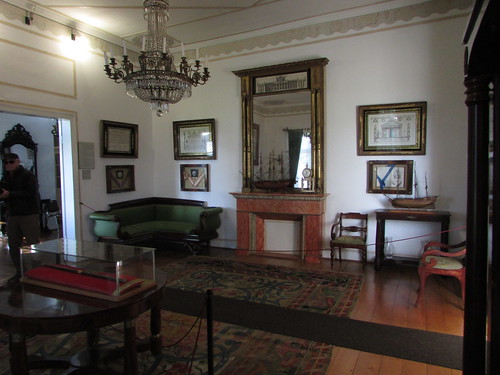
Valdivia Historical & Archaeological Museum.
We rejoined the tour bus to explore a little of the city, crossing the river using the Puente Pedro de Valdivia bridge (a 1940s concrete and steel affair) which survived the earthquake. The Plaza de la Republica is regarded as the centre of the city, with trees, flower beds, broad walkways and a magnificent bandstand. Nearby, a man operating a shoe-shine business was patiently waiting for trade. We walked past the post-earthquake cathedral to reach the river bank, made into a wide promenade and serving as the loading point for the numerous trip boats which offer river cruises to tourists.
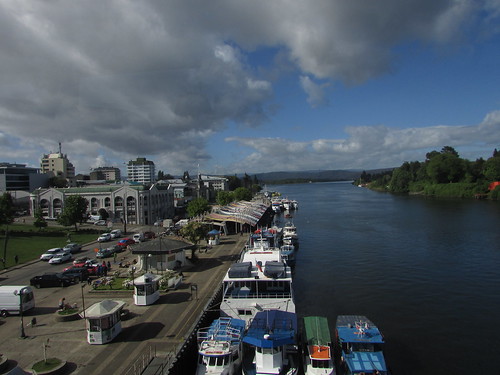
Valdivia, Chile.
Towards one end of the promenade, a modern, tall tower provided by the Centre for Scientific Studies at the University featured a Foucault’s Pendulum, topped with a navigation light. Nearby signage gave brief information on the pendulum and the Fresnel Lens used in most navigation lights, together with a map showing the location of ‘Chilean Glaciers in Antarctica’.
A little further along the river, a rather abandoned-looking submarine was moored, but I didn’t discover more at the time. Intrigued at finding a submarine in what seemed, to me, an unlikely spot on my return Wikipedia informed me that the vessel was the Chilean Navy 'Oberon' class submarine S22 O'Brien, built by Scott-Lithgow, commissioned in 1976 and de-commissioned sometime between 2000 and 20010. Then I was further intrigued by the Irish-sounding name. John Thomond O'Brien (1786–1861) fought in the Army of the Andes, helping Chile obtain its independence from Spain, gaining fame as did the Chilean hero Bernardo O'Higgins.
Along the promenade near the bridge we’d crossed, I visited the fish and vegetable market. Here, fish are gutted on concrete preparation benches next to the river, encouraging birds to perch on the railings awaiting discarded pieces of fish. Numerous bird species were represented, including pelicans. Even more improbable was the group of South American sealions, either relaxing in the sun on a nearby floating pontoon or actually on the concrete floor of the fish market, squeezed between the railings and unused gutting benches.
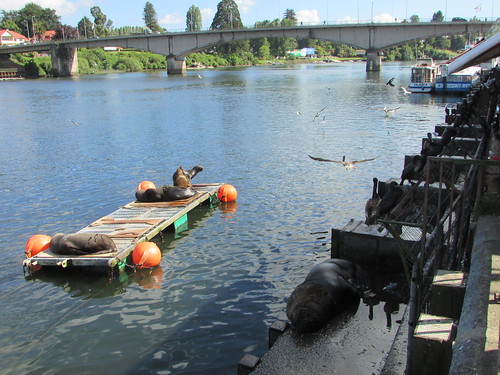
Valdivia, Chile: South American Sea lions and birds awaiting scraps at the fish market.
On the recommendation of our Chilean guide, a group of us crossed the road to look inside the modern municipal market, which seemed to house two or three cafes and numerous stalls selling tourist souvenirs.
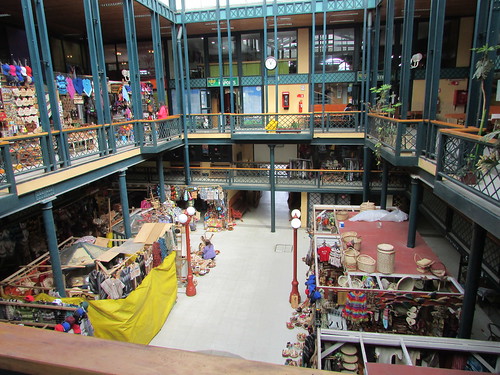
Valdivia Municipal Market.
Meeting up with our guide, we walked along the river bank, under the road bridge and past a modern floating restaurant under restoration. Next to the restaurant, an attractive steam launch was moored. A little further along the river bank, what appeared to be an abandoned wooden landing stage was occupied by around eight sealions, basking in the sun, watched attentively from the bank by two dogs. We then crossed the road to reach a sea food restaurant where we enjoyed a buffet lunch.
After our meal, our tour bus picked us up and returned us to Niebla Terminal. As I walked to the landing stage, vehicle ferry ‘Pitipulla’ was loading the last vehicle, which reversed up the loading ramp and reached the main deck with a loud ‘clang’. Within minutes, the ferry departed, as yet another vehicle approached the concrete ramp with another full load of vehicles including a huge lorry with the load space sheeted-over.
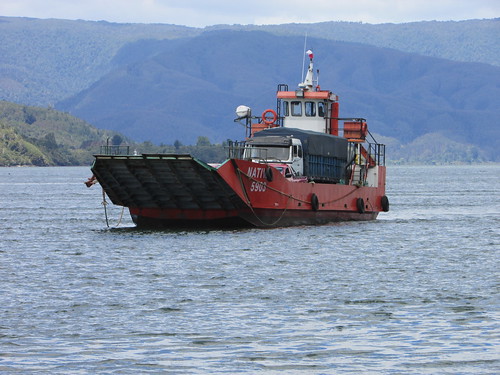
Niebla, Chile: Vehicle ferry approaching the busy public jetty.
Once aboard the Zodiac, I enjoyed a high speed ride of about one mile back to ‘Silver Explorer’. As soon as everyone was back on board and the Zodiacs had been lifted aboard, we got under way for our next destination, Chiloe Island.
Related Posts
Next post describing this trip: Achao and Castro.
All posts describing this trip: Chilean Fjords.
My pictures
Where necessary, clicking on an image above will display an 'uncropped' view or, alternately, my pictures from this (and earlier) trips may be selected, viewed or downloaded, in various sizes, from the albums listed:-
Pictures of Niebla and Valdivia are here.
Pictures of Valdivia Historical & Archaeological Museum are here.
Pictures aboard 'Silver Explorer' are here.
All my pictures of Chile can be found in the collection Chile.
[Pictures added, notes on submarine added 10-Jan-2017]
